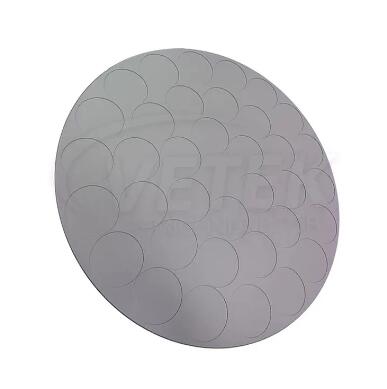Understanding SiC Coating Wafer Carriers: Enhancing Semiconductor Manufacturing
2024-08-19
Introduction
In the rapidly advancing world of semiconductor manufacturing, precision, durability, and efficiency are paramount. One of the critical components in this intricate process is the wafer carrier, which plays a vital role in transporting and processing semiconductor wafers. Among the various materials and coatings used for wafer carriers, Silicon Carbide (SiC) coating stands out for its exceptional properties. This blog will explore the significance of SiC coating wafer carriers, their key features, and how they contribute to the semiconductor manufacturing process.
What is a SiC Coating Wafer Carrier?
A SiC coating wafer carrier is a specialized tool used in semiconductor fabrication to hold and transport silicon wafers during various stages of the manufacturing process. These carriers are typically made from materials such as graphite or silicon carbide, and they are coated with a thin layer of SiC to enhance their performance.
Silicon carbide is a compound of silicon and carbon, known for its hardness, thermal conductivity, and chemical resistance. The SiC coating provides the wafer carrier with a protective layer that significantly improves its durability and performance, especially in high-temperature and corrosive environments.
Key Features of SiC Coating Wafer Carriers
1. High Thermal Stability:
SiC coating offers excellent thermal stability, making it ideal for use in high-temperature processes such as chemical vapor deposition (CVD) and epitaxy. The coating can withstand extreme temperatures without degrading, ensuring that the wafer carrier maintains its structural integrity and continues to perform effectively.
2. Superior Hardness and Wear Resistance:
Silicon carbide is one of the hardest materials available, providing the wafer carrier with exceptional wear resistance. This hardness helps protect the carrier from scratches, abrasions, and other forms of mechanical damage that can occur during the handling and transport of wafers.
3. Chemical Resistance:
The SiC coating provides excellent resistance to chemicals and corrosive substances commonly used in semiconductor manufacturing. This resistance ensures that the wafer carrier remains unaffected by the harsh chemicals, maintaining its performance and extending its lifespan.
4. Low Thermal Expansion:
One of the critical challenges in semiconductor manufacturing is managing thermal expansion. SiC coating has a low coefficient of thermal expansion, meaning it undergoes minimal expansion or contraction with temperature changes. This stability is crucial for maintaining the precision and accuracy required in the semiconductor fabrication process.
5. High Purity and Low Contamination:
The SiC coating is highly pure, reducing the risk of contamination during wafer processing. This purity is essential for maintaining the integrity of the semiconductor wafers and preventing defects that could affect the performance of the final electronic devices.
Applications of SiC Coating Wafer Carriers
SiC coating wafer carriers are used in various stages of semiconductor manufacturing, where their unique properties provide significant advantages. Some key applications include:
- Chemical Vapor Deposition (CVD): In CVD processes, wafers are exposed to high temperatures and reactive gases. SiC coating wafer carriers can withstand these conditions, ensuring the safe transport and processing of wafers without contamination.
- Epitaxy: During epitaxial growth, thin layers of semiconductor material are deposited onto the wafer. The low thermal expansion and high purity of SiC-coated carriers help maintain the precision required for this process.
- Diffusion and Oxidation: These processes involve high temperatures and corrosive environments. SiC coating wafer carriers resist chemical attack and thermal degradation, ensuring consistent and reliable wafer processing.
- Wet Etching: In wet etching processes, wafers are exposed to corrosive chemicals to remove material selectively. The chemical resistance of SiC-coated carriers prevents damage and ensures the longevity of the carrier.
Benefits of Using SiC Coating Wafer Carriers
1. Enhanced Durability and Longevity: The hardness, wear resistance, and chemical stability of SiC coating significantly extend the lifespan of wafer carriers, reducing the need for frequent replacements and lowering overall costs.
2. Improved Wafer Quality: The high purity and low contamination risk associated with SiC coatings help maintain the quality of the semiconductor wafers, leading to better performance and yield in the final electronic devices.
3. Reduced Downtime: The durability and resistance of SiC-coated carriers reduce the likelihood of carrier failure or damage, minimizing production downtime and improving overall efficiency in the manufacturing process.
4. Cost-Effective: Although SiC coating wafer carriers may have a higher initial cost, their extended lifespan, reduced maintenance, and improved process efficiency make them a cost-effective solution in the long run.
Conclusion
SiC coating wafer carriers are a critical component in the semiconductor manufacturing process, offering unmatched durability, thermal stability, and chemical resistance. These carriers play a vital role in ensuring the safe and efficient transport and processing of wafers, ultimately contributing to the production of high-quality semiconductor devices. By understanding the benefits and applications of SiC coating wafer carriers, manufacturers can make informed decisions that enhance their processes and improve their overall production outcomes.



